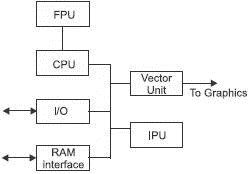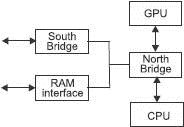Книга: Introduction to Microprocessors and Microcontrollers
Games machines
Games machines
If we only needed computers to allow us to handle text on a word processor, there would be little need for the development that has occurred in the last ten years – our typing is not getting faster and text is simple stuff. Introducing coloured pictures does little to increase the stress levels but things really start to change when we want to have moving coloured pictures.
We are never satisfied: we want faster-changing, more lifelike images – with sound effects, of course. Our demands will outstrip the latest microprocessors almost regardless of their capability.
Many computers are used mostly for playing games and simulations but because they have other functions they must be designed to operate across a wide range of fields and not really optimized for any particular task. This has resulted in the development of the dedicated games machine. We have a choice of three at the moment – they are the Nintendo Gamecube, the Playstation and the X-Box.
Nintendo Gamecube
This is the oldest design and, inevitably, the least technically advanced. It is generally cheap to buy the cube and the games are also cheap and are most popular amongst users in the lower age groups.
They decided to use a 64-bit, 85 MHz, IBM PowerPC 750Cxe microprocessor, also called the ‘Gekko’ which was its original codename during the production stages. It is a slightly modified version of the one used in Macintosh computers and similar to those described in Chapter 13. The modifications were software additions of almost forty additional instructions to provide specific help in game playing but not necessary in the original computer applications.
The quality of the graphics during play can be indicated by the speed of handling graphic data which is conveniently measured by how many shapes it is able to draw in one second. In this case the chosen ATI 162 MHz Flipper GPU (Graphics Processor Unit) has a maximum speed of 12 million polygons/second – this sounds fast but compared with the Playstation 2 and the X-box it is not impressive.
The main game storage is a 1.5 GB 3 inch Nintendo optical disk. There is also a facility for a 64 MB memory card supplied by Panasonic.
Sony Playstation 2
Rather than taking a ready-made microprocessor off the shelf and then designing a games machine around it, Sony started by designing their own microprocessor called the ‘Emotion Engine’ designed just to run games programs as fast as possible. This ‘single job’ approach allows the design to be very focused. The microprocessor is surrounded by the necessary circuitry to provide the necessary inputs and outputs. The overall blocks are shown in Figure 11.9.

Figure 11.9 Playstation 2
If we load a game from a DVD, the startup information is passed to the Emotion Engine which prepares the game graphics and sound in either analog or digital format. It then waits for input instructions arriving from our controller or through the USB ports.
Inside the Emotion Engine, shown in Figure 11.10, our controller information arrives through the Input/Output unit and the fun begins.

Figure 11.10 The Emotion Engine
Games involve serious numbers of calculations and they can be very complex. There are two types of calculations: straightforward calculations (just the sort of thing we could do on a pocket calculator) and geometric calculations. The ordinary calculations are performed by the FPU (Floating-Point Unit) and the others are done by the VU (Vector Unit). So why so many calculations?
Does the car skid on the corner? This depends on how fast you are telling it to turn, what speed you are driving at, the weather selected and the car data. What is going to happen if you ‘accidentally’ hit a tree or another vehicle?
These calculations have to be done in real time – if we turn the steering wheel the car has to respond immediately. The geometric calculations are performed by the Vector unit, which provides the results of what is happening on screen. It also prepares the list of events that control everything that appears on the screen – right down to the path taken by the wheel that has broken off and the reflection in the driver’s mirror.
To a large extent, the final quality of the game experience depends on the speed of these calculations. Floating point calculations are performed at more than six billion a second! That is moving.
So, how good is the Playstation 2?
That is too difficult to answer. Instead we can look at the technical information but there is much more. Does the controller feel good? Are the games exciting and realistic? Does an hour on the PS2 seem like minutes or weeks?
Generally, the console is fairly expensive but, having bought it, the games are cheap(ish). The thinking behind this is we only buy the PS2 once and soon forget how much it cost, especially if it was a gift, but we can afford plenty of games. Having plenty of games reduces the attraction of changing to another games machine – like the Xbox.
The Emotion Engine runs at only 294 MHz but these headline speeds are not a good indication of how fast it can do its job – this also depends on how well it has been designed for the job. You may remember that the Gamecube microprocessor was running at 485 MHz, more than 50% faster than the PS2, but look at the drawing speeds: Gamecube 12 million polygons/sec, PS2 25 million polygons/sec, double the speed. This compares a general-purpose computer microprocessor with a dedicated device.
The Microsoft Xbox
The Xbox is the latest offering in this market. They have opted for the opposite strategy to the Playstation 2 by making the console fairly cheap but charging more for the games. Presumably, the name of Microsoft together with an attractive upfront price will mean the boxes are carried out the shops and we will worry about the games later. They seem to sell to an older group than the other two and perhaps the price of games may not be such a barrier.

Figure 11.11 The Xbox
The microprocessor chosen for this machine is the Pentium 3 running at 733 MHz. They have gone for a standard micro rather than a specialized design but even so, it has got such power that it can blast through a game at a good rate. The geometric drawing speed of textured polygons is 50 million per second or twice the speed on the PS2 or eight times that of the Gamecube. In all cases, the polygon count has texture included. The bare polygon is a simple wire-frame shape without any surface coloring which is essential to provide reality to the scene.
The North Bridge chip is the central block of the Xbox and provides interconnections between the other units. It controls access to the 64 MB memory that provides a cache for the use of the CPU (Central Processing Unit) to store program code and a larger share for the GPU (Graphics Processing Unit). The North Bridge also sends signals to the South Bridge chip.
The South Bridge provides all the external inputs and outputs via the USB and network ports together with the audio signals.
The GPU design shown in Figure 11.12 is called the ‘nVidia’ is based on the GeForce 3 design, another popular computer component. The graphic processor converts the CPU output into the finished information being sent to the CPU or television.

The Figure 11.12 The graphics chip
The information about each object on the screen such as its position, the lighting applied and the surface appearance is prepared together with two features that are used to decrease the computing power necessary or to improve the appearance with the same processor. The ‘pixel shader’ that can apply realistic lighting and surface texture effects over a whole scene without each individual point being calculated separately and the vertex program oversees the detailed changes that are necessary in critical areas. We tend to be very selective when it comes to details, we would notice the slightest change in a facial expression yet ignore whole leaves on a tree. By controlling light and texture characteristics, the vertex shader fills in details of these small but important changes.
- Micros are getting bigger – and faster
- How do we measure the speed of a microprocessor?
- FLOPS (FLoating-point Operations Per Second)
- How to make a microprocessor go faster?
- Making more use of each clock pulse
- RISC and CISC
- Who did what, when
- The microcontroller
- Increasing the number of bits
- Where do we go from here?
- Games machines
- Quiz time 11
- Games
- Placement of NAT machines
- CHAPTER 9 Games
- Installing Popular Games in Fedora
- Playing Windows Games with Cedega
- Using scp to Copy Individual Files Between Machines
- Using sftp to Copy Many Files Between Machines
- CHAPTER 30 Securing Your Machines
- Fedora on Multicore Machines
- 7.3. Проблемы с сетевым адаптером ноутбука Acer eMachines E525
- 10.1 State Machines
- Глава 8 Ветвь реестра НKEY_LOCAL_MACHINESYSTEM




